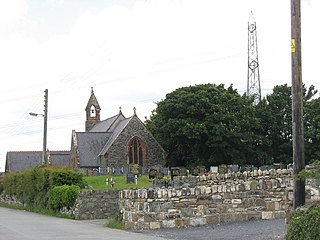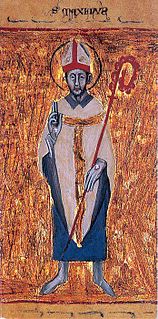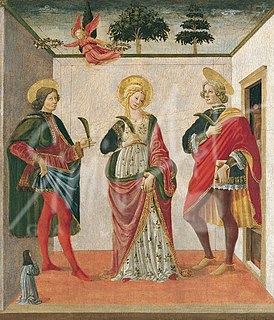Related Research Articles

The First Council of Constantinople was a council of Christian bishops convened in Constantinople in AD 381 by the Roman Emperor Theodosius I. This second ecumenical council, an effort to attain consensus in the church through an assembly representing all of Christendom, except for the Western Church, confirmed the Nicene Creed, expanding the doctrine thereof to produce the Niceno-Constantinopolitan Creed, and dealt with sundry other matters. It met from May to July 381 in the Church of Hagia Irene and was affirmed as ecumenical in 451 at the Council of Chalcedon.
The 380s decade ran from January 1, 380, to December 31, 389.

The pontifex maximus was the chief high priest of the College of Pontiffs in ancient Rome. This was the most important position in the ancient Roman religion, open only to patricians until 254 BC, when a plebeian first occupied this post. Although in fact the most powerful office in the Roman priesthood, the pontifex maximus was officially ranked fifth in the ranking of the highest Roman priests, behind the rex sacrorum and the flamines maiores.

Saint Elen, often anglicized as Helen, was a late 4th-century founder of churches in Wales. Traditionally, she is said to have been a daughter of the Romano-British ruler Octavius / Eudaf Hen and the wife of Magnus Maximus / Macsen Wledig, the 4th-century emperor in Britain, Gaul, and Spain who was killed in battle in 388. Although never formally canonized by Rome, Elen is traditionally considered a saint in the Welsh Church; in English she is sometimes known as Saint Helen of Caernarfon to distinguish her from Saint Helena.

Maximus the Confessor, also known as Maximus the Theologian and Maximus of Constantinople, was a Christian monk, theologian, and scholar.
A pontiff was, in Roman antiquity, a member of the most illustrious of the colleges of priests of the Roman religion, the College of Pontiffs. The term "pontiff" was later applied to any high or chief priest and, in Roman Catholic ecclesiastical usage, to a bishop and more particularly to the Bishop of Rome, the Pope or "Roman Pontiff".
Dionotus was a legendary king of Cornwall in Geoffrey of Monmouth's Historia regum Britanniae, an account of the rulers of Britain based on ancient Welsh sources and disputed by many historians. Dionotus succeeding his brother Caradocus, and was regent of Britain during the campaigns in Gaul of Emperor Magnus Maximus. The curious thing about this king is that the Welsh chronicles, which parallel most of Geoffrey of Monmouth's book, do not mention this king by name. However, Geoffrey uses Latin versions of Welsh names so he could be referring to Dynod, duke of Cornwall, or Anwn Dynod, Maximus's own son. The latter would probably be Conan Meriadoc another son of Caradoc of Cornwall.
Pope Maximus of Alexandria, 15th Pope and Patriarch of Alexandria. He is commemorated in the Coptic Synaxarion on the 14th day of Baramudah, and by the Romans on Dec. 27.
Saint Maximus was a Christian saint and martyr.

Saint Felix of Nola was a Christian presbyter at Nola near Naples in Italy. He sold off his possessions in order to give to the poor, but was arrested and tortured for his Christian faith during the persecution of the Roman emperor Decius. He was believed to have died a martyr's death during the persecution of Decius or Valerian, but is now listed in the General Roman Calendar as a confessor of the faith, who survived his tortures.

Saint Catherine of Alexandria is an oil painting by the Italian Baroque master Caravaggio, painted from 1598-1599. It is part of the Thyssen-Bornemisza Collection of Madrid.

Saint Julius the Veteran, also known as Julius of Durostorum, is a Roman Catholic, Anglican and Eastern Orthodox saint and martyr. His feast day is 27 May.

Andronicus, Probus (Provos), and Tarachus were martyrs of the Diocletian persecution. According to tradition, Tarachus was beaten with stones. Probus was thrashed with whips, his back and sides were pierced with heated spits; finally he also was cut up with knives. Andronicus was also cut to pieces with knives.

Maximus of Turin (Italian: San Massimo; is the first known Christian bishop of Turin. He was a theological writer who "made a great contribution to the spread and consolidation of Christianity in Northern Italy".

Saints Digna and Emerita are venerated as saints by the Catholic Church. They were Roman maidens seized and put to the torture as Christians in the persecution of Valerian at Rome.

Felicitas of Rome, also anglicized as Felicity, is a saint numbered among the Christian martyrs. Apart from her name, the only thing known for certain about this martyr is that she was buried in the Cemetery of Maximus, on the Via Salaria on a 23 November. However, a legend presents her as the mother of the seven martyrs whose feast is celebrated on 10 July. The Eastern Orthodox Church celebrates their martyrdom on 25 January.
Saint Maximus of Aveia is one of the patron saints of L'Aquila, Italy.
Saint Maximus of Jerusalem was an early Christian saint and bishop of Jerusalem from roughly 333 AD to his death in 347 AD. He was the third bishop of Jerusalem named Maximus, the other two being in the latter half of the 2nd century.

The Church Fathers, Early Church Fathers, Christian Fathers, or Fathers of the Church were ancient and influential Christian theologians and writers who established the intellectual and doctrinal foundations of Christianity. The historical period in which they worked became known as the Patristic Era and spans approximately from the late 1st to mid 8th centuries, flourishing in particular during the 4th and 5th centuries, when Christianity was in the process of establishing itself as the state church of the Roman Empire.

Saints Tiburtius, Valerian, and Maximus are three Christian martyrs who were buried on 14 April of some unspecified year in the Catacombs of Praetextatus on the Via Appia near Rome.
References
- ↑ St. Maximus Catholic Online, http://www.boston-catholic-journal.com/roman-martrylogy-in-english/roman-martyrology-january-in-english.htm#January_8th
- ↑ Benedictine Monks of Saint Augustine's Abbey, Ramsgate (2015) [1921]. The Book of Saints. Aeterna Press.